 Technology peripherals
Technology peripherals
 AI
AI
 Interpretation from the Stanford HAI Institute: The 'Chip Act' spends US$280 billion, how much can the AI industry get?
Interpretation from the Stanford HAI Institute: The 'Chip Act' spends US$280 billion, how much can the AI industry get?
Interpretation from the Stanford HAI Institute: The 'Chip Act' spends US$280 billion, how much can the AI industry get?
Yesterday, the US$280 billion "Chip Bill" was officially signed, immediately triggering heated discussions. The capital market gave a strong negative response, and the stocks of major chip manufacturers fell sharply.

However, whether it is the media or the market, the focus is all on "chips", and they have probably ignored that the full name of this bill is "Chip and Science Act."
In fact, of the US$280 billion, the subsidies for "chips" totaled more than 54 billion, and the remaining more than 200 billion were all given to "science." Obviously, the latter is the big one.
Regarding the more than 54 billion yuan subsidized to the chip industry, a large number of articles have analyzed it thoroughly in recent days. So who took away the more than 200 billion yuan to support "research and innovation"?
According to the summary of the bill published by the House of Representatives Science Committee, it was mainly divided up by government departments and major large research funding agencies.

Mainly include the National Science Foundation (NSF), the National Institute of Standards and Technology (NIST), the Department of Energy, and the Department of Commerce.
Among them, the two companies that have received the most are NSF and the Department of Energy. In the next five years, they will receive at least US$81 billion and US$67.9 billion. This is just the basic budget. If additional additions are included, they can receive more respectively. Get more than 30 billion US dollars more.
In comparison, the budget of more than 54 billion US dollars in chip subsidies suddenly seems not that much.
With more than 200 billion US dollars, how much can the AI industry get?
As soon as the bill was enacted, the HAI Institute of Stanford University, which Li Feifei co-founded, analyzed the specific whereabouts of the money in the bill. Of course, their focus was not on chips, but on AI.
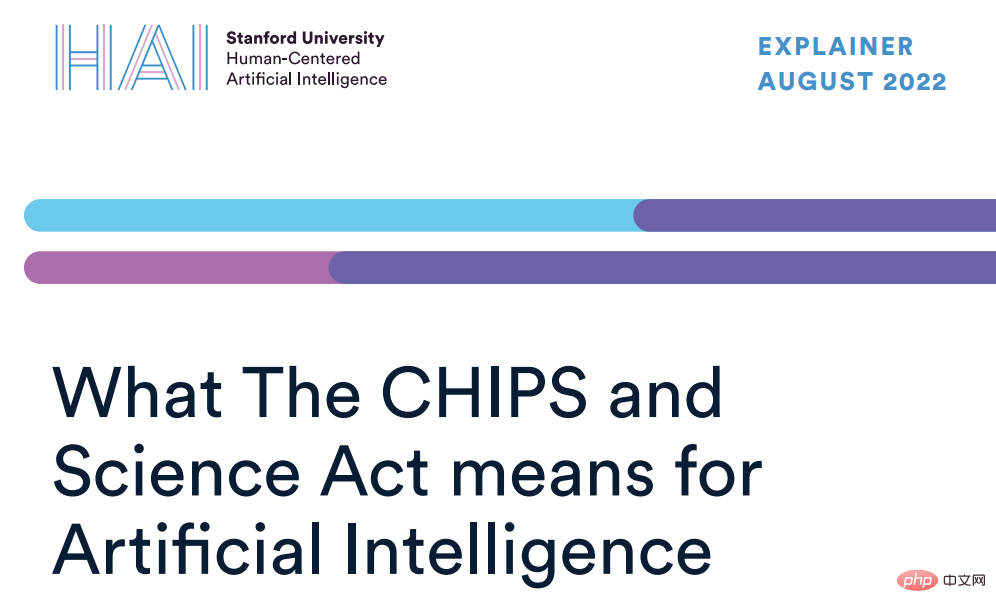
This article mainly analyzes the impact of the "Chip and Science Act" on AI. In terms of specific content, it is actually to see what money can be allocated to AI-related research and projects. .
HAI analysis believes that most of these investments are related to AI.
For example, investment in the semiconductor industry will provide impetus for the research and development of machine learning and artificial intelligence. Some investments are specifically targeted at AI, and AI-related funding projects are specifically listed in the bill. A table.
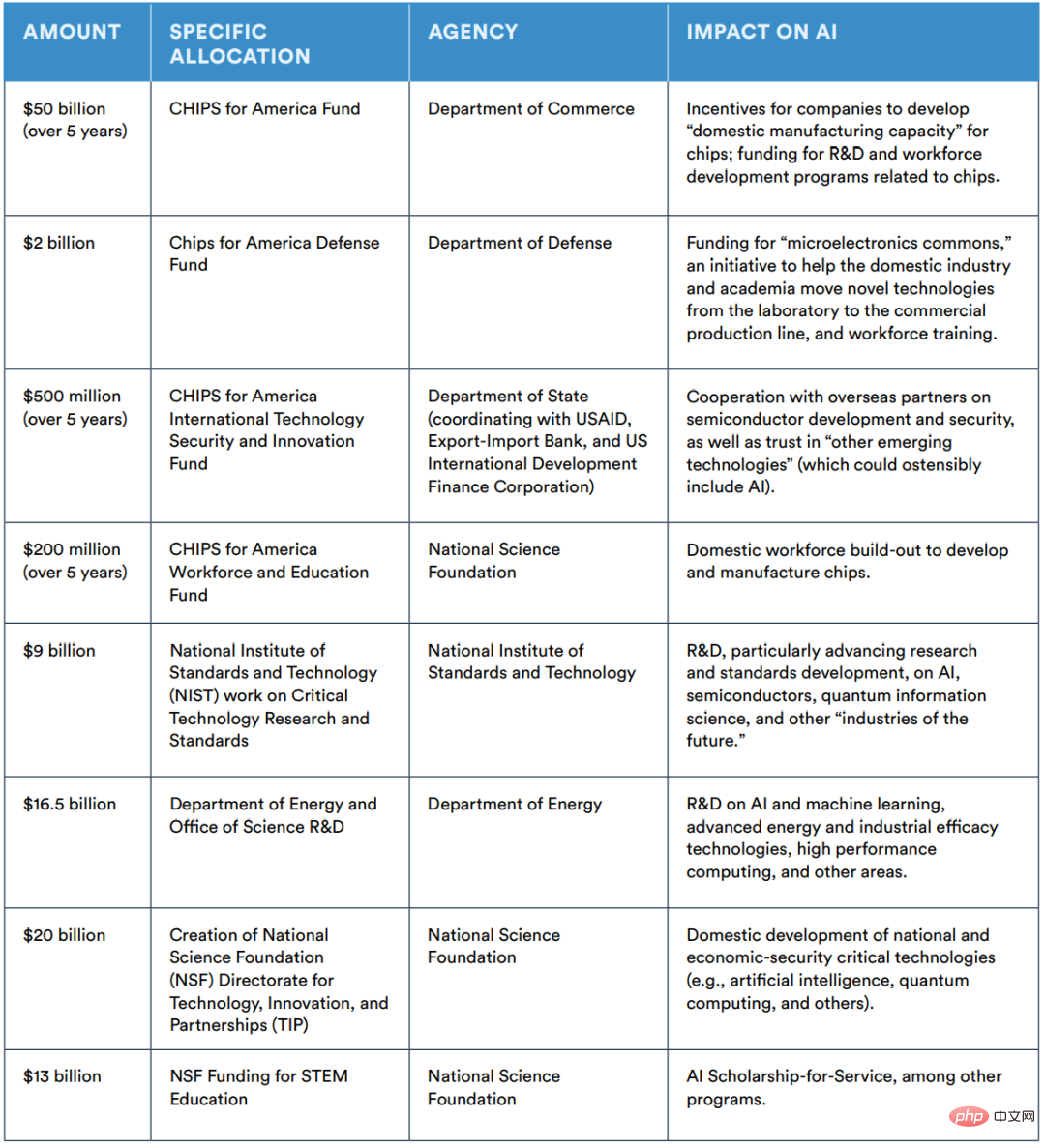
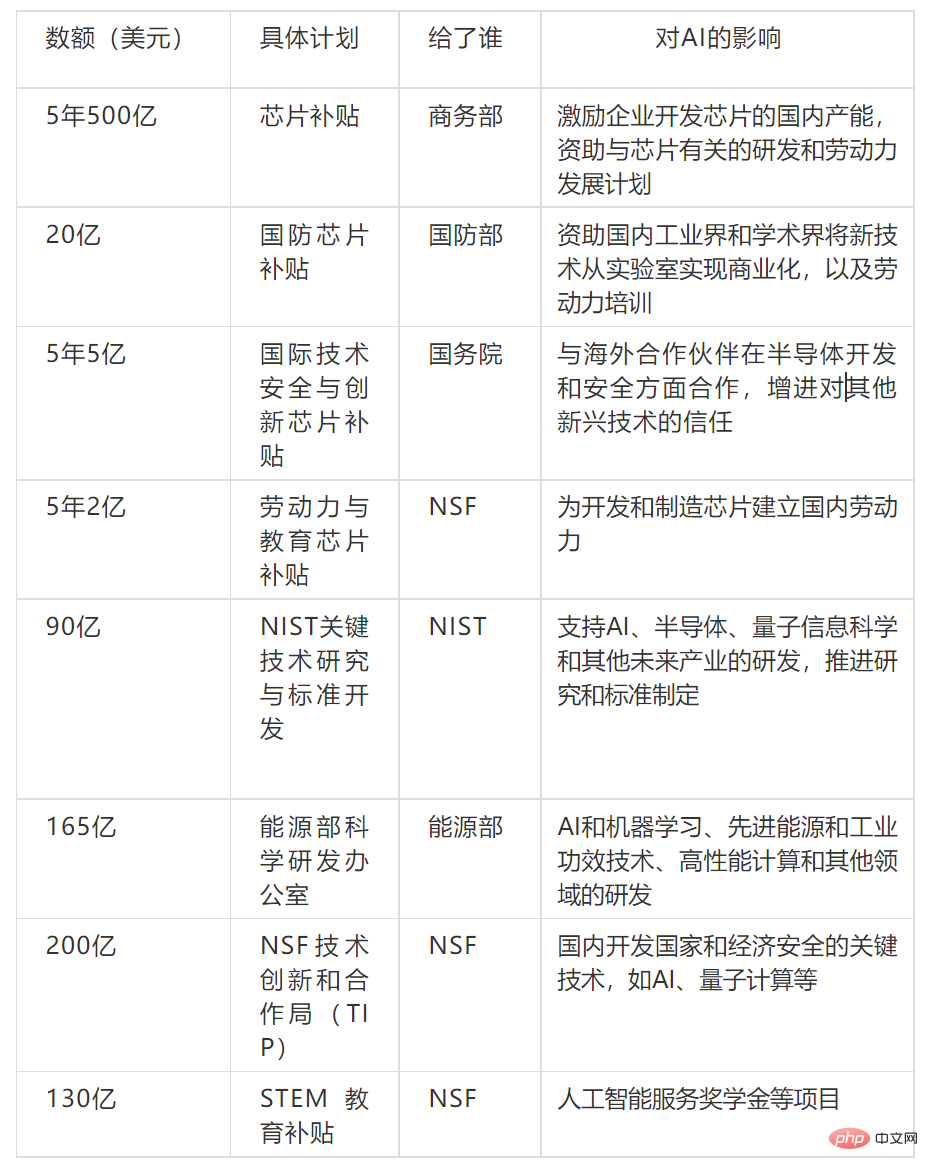
What terms are related to AI?
This chip bill has a lot of investment projects in AI. The main purpose is to expand existing plans related to artificial intelligence research and development and workforce development.
Section 10232 of the bill specifically addresses artificial intelligence, requiring the NIST director to "continue to support the development of artificial intelligence and data science and conduct activities under the National Artificial Intelligence Initiative Act of 2020," which is also 2021 Part of the National Defense Authorization Act 2021.
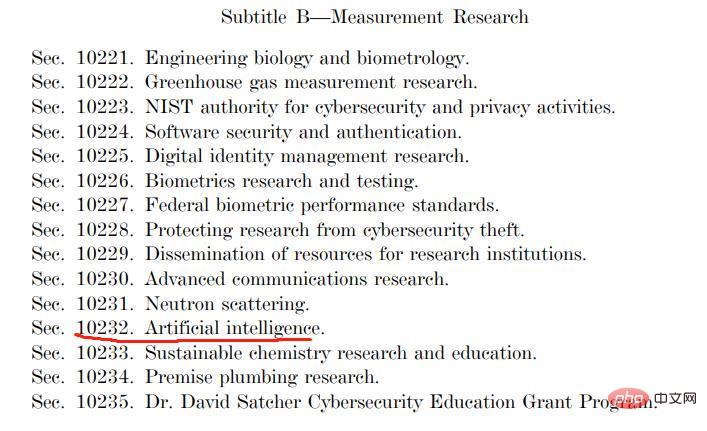
The specific contents of this Section 10232 include:
- Expand the capabilities of the institute, including scientific researchers and research infrastructure;
- Support measurement R&D systems for advanced computer chips and hardware designed for AI;
- Support the development of technical standards and guidelines that promote safe and trustworthy AI systems, such as improving accuracy in AI systems, Explainability, privacy, reliability, robustness, security;
- Create a framework for managing risks associated with artificial intelligence systems;
- Develop cybersecurity tools for artificial intelligence and data science , encryption methods and best practices;
The bill also amends the NIST Act to allow the director of NIST to work with other private sector and higher education institutions to establish a "virtual test bed" for "developing artificial intelligence and machine learning systems, including testing platforms that examine vulnerabilities and conditions that may lead to malfunctions, malfunctions, or attacks on such systems.”
In addition, there are other AI-related laws and regulations including:
- Section 10224: Directs NIST to establish an artificial intelligence defense research program;
- Section 10313: Authorizes NSF to create a federal AI scholarship program, similar to the CyberCorps scholarship (in which students receive scholarships to take Internet-related courses , and commits to provide government services for a period of time);
- Section 10360: Directs NSF to conduct public research on university artificial intelligence research capabilities, factors for research success, and geographic distribution;
- Section 10771: Authorizes grants for artificial intelligence and information technology from the Department of Energy’s Office of Environmental Management
Stanford HAI founded by Li Feifei
Let’s take a look at this again The analysis organization of this report is the Human-Centered AI Institute (HAI) of Stanford University.
The institution was established on March 18, 2019. Li Feifei, a giant in the AI industry, and John Etchemendy, former provost and professor of philosophy at Stanford University, jointly serve as deans of the institute.

HAI is composed of approximately 200 faculty members from seven schools at Stanford University, bringing together multidisciplinary researchers in computer science, neurobiology, economics, philosophy, etc. , and also hired industry experts such as former Google CEO Eric Schmidt as members of the advisory team.
is committed to the research, guidance and development of human-centered artificial intelligence technology and applications, and strengthens cooperation with industry (involving technology, financial services, health care and manufacturing, etc.), government and non-governmental organizations, through artificial intelligence Intelligence realizes a better future for mankind.
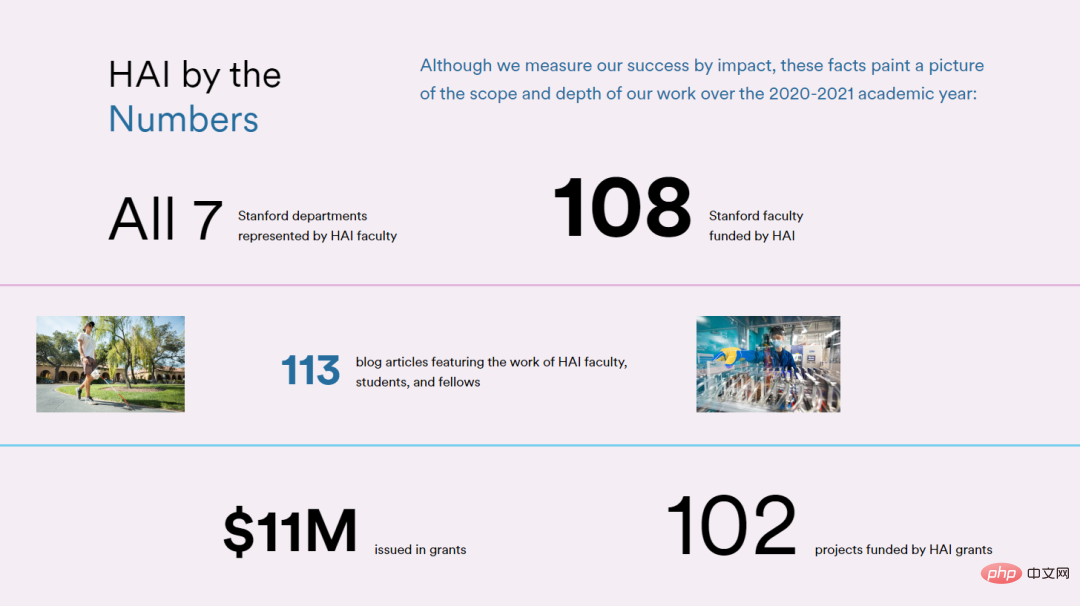
Stanford University President Marc Tessier Lavigne delivered a speech at the institute’s unveiling forum, saying that artificial intelligence has shown great potential in improving human life, but at the same time it also Bringing many potential risks, HAI was established to reduce the harm of artificial intelligence and better use artificial intelligence to improve the quality of human life.
Li Feifei said, "It is urgent to incorporate ethical research into the basis of artificial intelligence research and development."
HAI was born from three simple but powerful ideas: the development of artificial intelligence should be guided by its impact on human society; artificial intelligence should enhance human skills rather than replace humans; artificial intelligence should be more Incorporate more of the diversity, difference, and depth of human intelligence.
She said that HAI tries to achieve the following goals: make breakthroughs in interdisciplinary research collaboration; build a forum that broadly brings together global ideas; promote artificial intelligence education and popularization; influence policy and promote change.
The above is the detailed content of Interpretation from the Stanford HAI Institute: The 'Chip Act' spends US$280 billion, how much can the AI industry get?. For more information, please follow other related articles on the PHP Chinese website!

Hot AI Tools

Undresser.AI Undress
AI-powered app for creating realistic nude photos

AI Clothes Remover
Online AI tool for removing clothes from photos.

Undress AI Tool
Undress images for free

Clothoff.io
AI clothes remover

Video Face Swap
Swap faces in any video effortlessly with our completely free AI face swap tool!

Hot Article

Hot Tools

Notepad++7.3.1
Easy-to-use and free code editor

SublimeText3 Chinese version
Chinese version, very easy to use

Zend Studio 13.0.1
Powerful PHP integrated development environment

Dreamweaver CS6
Visual web development tools

SublimeText3 Mac version
God-level code editing software (SublimeText3)

Hot Topics
 1653
1653
 14
14
 1413
1413
 52
52
 1304
1304
 25
25
 1251
1251
 29
29
 1224
1224
 24
24
 Recommended reliable digital currency trading platforms. Top 10 digital currency exchanges in the world. 2025
Apr 28, 2025 pm 04:30 PM
Recommended reliable digital currency trading platforms. Top 10 digital currency exchanges in the world. 2025
Apr 28, 2025 pm 04:30 PM
Recommended reliable digital currency trading platforms: 1. OKX, 2. Binance, 3. Coinbase, 4. Kraken, 5. Huobi, 6. KuCoin, 7. Bitfinex, 8. Gemini, 9. Bitstamp, 10. Poloniex, these platforms are known for their security, user experience and diverse functions, suitable for users at different levels of digital currency transactions
 Which of the top ten currency trading platforms in the world are the latest version of the top ten currency trading platforms
Apr 28, 2025 pm 08:09 PM
Which of the top ten currency trading platforms in the world are the latest version of the top ten currency trading platforms
Apr 28, 2025 pm 08:09 PM
The top ten cryptocurrency trading platforms in the world include Binance, OKX, Gate.io, Coinbase, Kraken, Huobi Global, Bitfinex, Bittrex, KuCoin and Poloniex, all of which provide a variety of trading methods and powerful security measures.
 What are the top ten virtual currency trading apps? The latest digital currency exchange rankings
Apr 28, 2025 pm 08:03 PM
What are the top ten virtual currency trading apps? The latest digital currency exchange rankings
Apr 28, 2025 pm 08:03 PM
The top ten digital currency exchanges such as Binance, OKX, gate.io have improved their systems, efficient diversified transactions and strict security measures.
 How much is Bitcoin worth
Apr 28, 2025 pm 07:42 PM
How much is Bitcoin worth
Apr 28, 2025 pm 07:42 PM
Bitcoin’s price ranges from $20,000 to $30,000. 1. Bitcoin’s price has fluctuated dramatically since 2009, reaching nearly $20,000 in 2017 and nearly $60,000 in 2021. 2. Prices are affected by factors such as market demand, supply, and macroeconomic environment. 3. Get real-time prices through exchanges, mobile apps and websites. 4. Bitcoin price is highly volatile, driven by market sentiment and external factors. 5. It has a certain relationship with traditional financial markets and is affected by global stock markets, the strength of the US dollar, etc. 6. The long-term trend is bullish, but risks need to be assessed with caution.
 What are the top currency trading platforms? The top 10 latest virtual currency exchanges
Apr 28, 2025 pm 08:06 PM
What are the top currency trading platforms? The top 10 latest virtual currency exchanges
Apr 28, 2025 pm 08:06 PM
Currently ranked among the top ten virtual currency exchanges: 1. Binance, 2. OKX, 3. Gate.io, 4. Coin library, 5. Siren, 6. Huobi Global Station, 7. Bybit, 8. Kucoin, 9. Bitcoin, 10. bit stamp.
 Which of the top ten currency trading platforms in the world are among the top ten currency trading platforms in 2025
Apr 28, 2025 pm 08:12 PM
Which of the top ten currency trading platforms in the world are among the top ten currency trading platforms in 2025
Apr 28, 2025 pm 08:12 PM
The top ten cryptocurrency exchanges in the world in 2025 include Binance, OKX, Gate.io, Coinbase, Kraken, Huobi, Bitfinex, KuCoin, Bittrex and Poloniex, all of which are known for their high trading volume and security.
 How to measure thread performance in C?
Apr 28, 2025 pm 10:21 PM
How to measure thread performance in C?
Apr 28, 2025 pm 10:21 PM
Measuring thread performance in C can use the timing tools, performance analysis tools, and custom timers in the standard library. 1. Use the library to measure execution time. 2. Use gprof for performance analysis. The steps include adding the -pg option during compilation, running the program to generate a gmon.out file, and generating a performance report. 3. Use Valgrind's Callgrind module to perform more detailed analysis. The steps include running the program to generate the callgrind.out file and viewing the results using kcachegrind. 4. Custom timers can flexibly measure the execution time of a specific code segment. These methods help to fully understand thread performance and optimize code.
 Decryption Gate.io Strategy Upgrade: How to Redefine Crypto Asset Management in MeMebox 2.0?
Apr 28, 2025 pm 03:33 PM
Decryption Gate.io Strategy Upgrade: How to Redefine Crypto Asset Management in MeMebox 2.0?
Apr 28, 2025 pm 03:33 PM
MeMebox 2.0 redefines crypto asset management through innovative architecture and performance breakthroughs. 1) It solves three major pain points: asset silos, income decay and paradox of security and convenience. 2) Through intelligent asset hubs, dynamic risk management and return enhancement engines, cross-chain transfer speed, average yield rate and security incident response speed are improved. 3) Provide users with asset visualization, policy automation and governance integration, realizing user value reconstruction. 4) Through ecological collaboration and compliance innovation, the overall effectiveness of the platform has been enhanced. 5) In the future, smart contract insurance pools, forecast market integration and AI-driven asset allocation will be launched to continue to lead the development of the industry.



